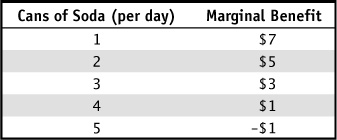
1. A nation has a productive lobster fishery off the coast. Which of the nation’s economic resources do the lobsters represent?
A. Labor
B. Land
C. Capital
D. Food
2. Kelly has a difficult decision to make concerning how she should spend two hours this evening. She can study for her economics exam, she can babysit and earn $10 per hour, or she can work at the campus library and earn $7 per hour. The opportunity cost of studying for her economics exam is:
A. $20
B. $17
C. $14
D. $34
3. When a consumer weighs the additional benefit of doing something against the additional cost of doing it, it is said that she is engaging in:
A. Resource analysis
B. Consumer analysis
C. Marginal analysis
D. Profit analysis
4. Which of the following headlines is best classified as a macroeconomic topic?
A. “The Ford plant in Louisville will rehire 100 production workers.”
B. “The price of gasoline has fallen by 10 percent since the weekend.”
C. “Motorola plans to introduce a new phone by Christmas.”
D. “The unemployment rate in the United States was reported to be 9.1 percent last month.”
Use Table 1 to answer question 5.
TABLE 1
5. Sherman enjoys buying cans of soda from the vending machine at his office. Cans of soda from the machine cost $1.50. Given Sherman’s daily marginal benefit for cans of soda, he will buy _____ each day.
A. 5
B. 4
C. 3
D. 2
6. Josh purchases cans of soup (S) and video games (V) with his income of $100. His budget constraint can be written as:

Given this information, the most soup that Josh could buy with his income is:
A. 25 cans
B. 100 cans
C. 5 cans
D. 4 cans
7. Josh purchases cans of soup (S) and video games (V) with his income of $100. His budget constraint can be written as:

Given this information, which of the following combinations would lie on Josh’s budget constraint?
A. 50S and 2V
B. 10S and 10V
C. 20S and 2V
D. 10S and 3V
Use Table 2 for questions 8 and 9.
TABLE 2
8. Table 2 shows a consumer’s marginal utility from consuming additional slices of pizza. If this consumer eats 3 slices of pizza, how many utils of total utility will he enjoy?
A. 3
B. 45
C. 12
D. 30
9. Table 2 shows a consumer’s marginal utility from consuming additional slices of pizza. If there is no price for buying a slice of pizza, how many slices of pizza will maximize his total utility?
A. 6
B. 3
C. 7
D. 1
10. Brody is currently spending all of his income on coffee and bagels. The price of coffee is $2 per cup, and the price of bagels is $3 each. Suppose that Brody’s current marginal utility for a cup of coffee is 10 utils and his marginal utility for a bagel is 15 utils. Is there a way for Brody to adjust his consumption to increase his utility?
A. Yes. He should consume more bagels and less coffee.
B. Yes. He should consume more coffee and less bagels.
C. No. He has already maximized his utility.
D. Yes. He should consume more coffee and more bagels.
11. The demand for gasoline has decreased. Which of the following could have caused this to occur?
A. The price of gasoline increased.
B. Income increased, and gasoline is a normal good.
C. The price of cars and trucks increased.
D. Consumers expect the price of gasoline to rise in the future.
12. Which of the following best reflects the law of demand?
A. The price of gasoline increased, and Stan reduced his driving for a week.
B. Stan received a pay raise and bought a new bike.
C. The price of apples increased, and Stan bought a pound of oranges.
D. Stan saw a commercial for a new kind of frozen pizza and went to the store and bought one.
13. Suppose the price elasticity of demand for good X is 1.5. If the price of X falls by 5 percent, we expect quantity demanded to rise by:
A. 5 percent
B. 7.5 percent
C. 15 percent
D. 3.33 percent
14. When the price of carrots increases by 2 percent, suppose the quantity of peas demanded rises by 4 percent. Given this, we can say that:
A. Carrots and peas are normal goods, and the income elasticity is equal to 2.
B. Carrots and peas are complementary goods, and the cross-price elasticity is equal to 2.
C. Carrots and peas are substitute goods, and the cross-price elasticity is equal to  .
.
D. Carrots and peas are substitute goods, and the cross-price elasticity is equal to 2.
15. All else equal, when the price of laptop computers falls by 5 percent, we observe that computer manufacturers see total revenues increase. What explains this?
A. The demand for laptop computers is price-elastic.
B. The demand for laptop computers is price-inelastic.
C. Laptop computers and desktop computers are substitute goods.
D. Laptop computers are normal goods.
16. Mr. Funelli has a pizza restaurant. Which of the following is most likely a fixed input in his short-run production of pizzas?
A. The cans of tomato sauce that he buys from a supplier.
B. The number of students from the high school that he employs.
C. The electricity that he uses to operate the appliances.
D. The size of the kitchen and dining room.
Use Table 3 to answer questions 17 and 18.
TABLE 3
17. Given the short-run cost data in Table 3, what is the total fixed cost associated with producing 36 units of output?
A. $350
B. $100
C. $250
D. $50
18. Given the short-run cost data in Table 3, which of the following choices best describes the shape of the marginal cost curve?
A. Vertical
B. Upward-sloping
C. Downward-sloping
D. Horizontal
19. Which of the following production or cost equations is correctly stated?




20. Which of the following statements incorrectly describes short-run production and cost relationships?
A. When the marginal product of labor is falling, the marginal cost is rising.
B. When the marginal product of labor is less than the average product of labor, the average product is falling.
C. The vertical distance between the total cost and total variable cost curves is equal to total fixed cost.
D. When the marginal product of labor is falling, the total product of labor is falling.
21. Which of the following would cause the supply of carrot cake to increase?
A. Several suppliers of carrot cake have recently gone out of business.
B. The price of carrot cake has increased.
C. The price of raw carrots has decreased.
D. Consumer income has increased, and carrot cake is a normal good.
22. Suppose the price elasticity of supply of good Y is 2. If we observe that the quantity of good Y supplied has decreased by 6 percent, we can conclude that:
A. The price of good Y has decreased by 3 percent.
B. The price of good Y has increased by 2 percent
C. The price of good Y has decreased by 0.33 percent.
D. The price of good Y has decreased by 12 percent.
23. The law of supply is consistent with the notion that:
A. Supply curves are upward-sloping in both the short run and the long run.
B. Supply curves are horizontal in the short run and upward-sloping in the long run.
C. Supply curves are upward-sloping in the short run and vertical in the long run.
D. Supply curves are horizontal in the short run and vertical in the long run.
24. Last month the price of coffee was $2 per pound and 1,000 tons were supplied by producers. This month the price remained at $2, but 1,200 tons were supplied. It is most likely that:
A. The supply of coffee decreased.
B. The supply of coffee increased.
C. There was an upward movement along the fixed supply curve.
D. There was a downward movement along the fixed supply curve.
Use Figure 1 to answer question 25.
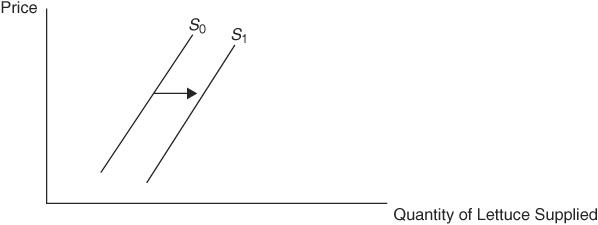
25. What may have caused the change seen in Figure 1?
A. The price of fertilizer increased.
B. The price of lettuce increased.
C. Workers conducted a labor stoppage to protest working conditions in the lettuce fields.
D. The price of cabbage, an alternative crop, decreased.
Use Figure 2 to answer questions 26 to 28.
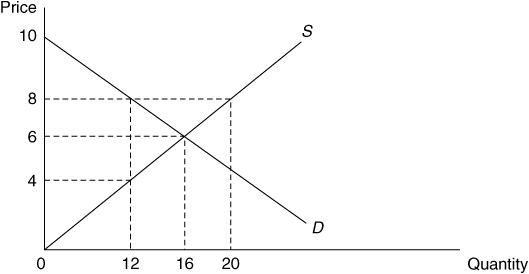
26. This market will come to equilibrium at a price of _____ and a quantity of _____.
A. $8; 16
B. $6; 16
C. $4; 12
D. $16; 6
27. In equilibrium, producer surplus is equal to:
A. $48
B. $24
C. $32
D. 16 units of output
28. Suppose the market in the graph is in equilibrium. What could cause the equilibrium price to rise to $8 and the quantity to rise to 20 units?
A. The price of a substitute good falls.
B. The price of an input used in producing this good falls.
C. Consumers’ preferences for this good weaken.
D. Consumer income rises, and this is a normal good.
29. The market for gasoline in the city of Smoggybottom is in equilibrium. Which of the following policies would create deadweight loss in the gasoline market?
A. A price floor
B. A price ceiling
C. An excise tax on each gallon supplied
D. All of the above
30. Assume the market for bread is in equilibrium. If the demand for bread increases and the supply of bread decreases, how will the price and quantity of bread change in the market?

31. A perfectly competitive firm is producing where profit is maximized and the price is below the average total cost. In the long run, what do we expect to happen to the number of firms in the industry, the market price of the product, and the firm’s level of output?

32. The perfectly competitive price of a grunk is $10. A profit-maximizing grunk producer calculates that the average total cost of making grunks is $7 and the average variable cost is $4. If the firm is producing 20 units, how much economic profit or loss is being made?
A. $60
B. $3
C. $200
D. −$20
Use Figure 3 for question 33.
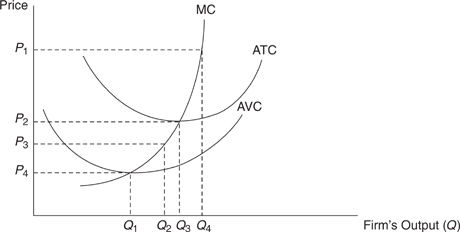
33. The long-run price and quantity for this perfectly competitive firm are:
A. P1 and Q4
B. P2 and Q3
C. P4 and Q1
D. P3 and Q3
34. Which of the following is not a long-run outcome of perfectly competitive markets?
A. Total welfare is maximized.
B. Average total costs are minimized.
C. Deadweight loss occurs.
D. Allocative efficiency is achieved.
Use Table 4 to complete question 35.
TABLE 4
35. If the market price is $7.50, what are the profit-maximizing level of output and the total economic profit or loss?
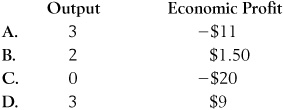
36. Which of the following choices correctly describes a monopolist?
A. Deadweight loss exists because the marginal cost exceeds the price of the last unit sold.
B. Rivals are blocked from entering the market in the short run, but entry is possible in the long run.
C. The marginal revenue earned from the next unit sold is less than the price at which it was sold.
D. Economic profits are not possible in the long run.
37. In the long run, the monopoly outcome is where:




38. If a profit-maximizing monopolist can engage in perfect price discrimination, ________________.
A. consumer surplus will equal producer surplus.
B. economic profit will equal zero.
C. deadweight loss will exist.
D. all consumer surplus will be transferred to the firm.
Use Figure 4 to answer questions 39 and 40.
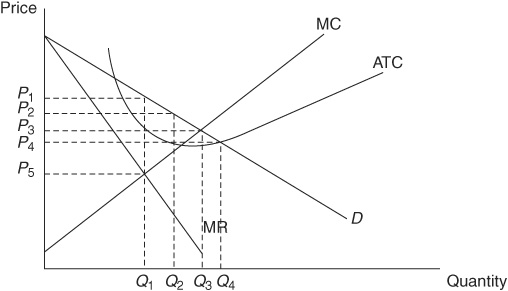
39. In Figure 4, the profit-maximizing output and price are:
A. Q3 and P3
B. Q1 and P5
C. Q1 and P1
D. Q4 and P4
40. Suppose the government wishes to regulate this monopolist so that profits are equal to zero. In this case, output is _____ and price is _____.




41. The grocery market in the city of Mossy Bottom is monopolistically competitive. Frannie’s Fresh Foods is currently maximizing her profit, and she is earning an economic profit. Given this, firms will _____ the Mossy Bottom grocery market, causing the demand for Frannie’s Fresh Foods to _____ and causing the price to _____ until profits are _____.
A. enter; decrease; increase; zero
B. exit; increase; decrease; zero
C. exit; decrease; increase; zero
D. enter; decrease; decrease; zero
42. Select the choice that is not consistent with the model of monopolistic competition.
A. Barriers to entry exist in the long run.
B. Product differentiation exists.
C. Economic profits are equal to zero in the long run.
D. Deadweight loss exists.
43. Suppose the grocery giants Kroger and Safeway are independently deciding whether to build a new store in Mexico City. The game matrix shown here gives the choices and payoffs of this game (in millions of dollars). If the game is played only once, are there any dominant strategies?
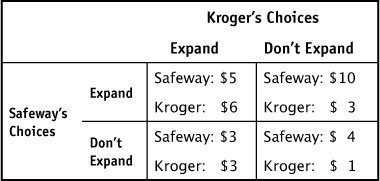
A. Yes. Choosing expand is the dominant strategy for both firms.
B. Yes. Choosing don’t expand is the dominant strategy for only Kroger.
C. Yes. Choosing expand is the dominant strategy for only Safeway.
D. No. Neither firm has a dominant strategy.
44. Suppose the grocery giants Kroger and Safeway are independently deciding whether to build a new store in Mexico City. The game matrix shown here gives the choices and payoffs of this game (in millions of dollars). If the game is played only once, what is the outcome?
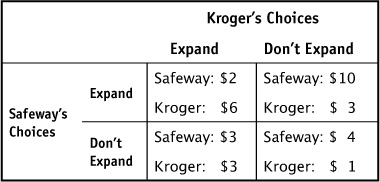
A. Both firms expand.
B. Kroger expands and Safeway does not expand.
C. Safeway expands and Kroger does not expand.
D. Both firms choose to not expand.
45. Which of the following scenarios best describes an oligopoly?
A. There is only one bank in a small town.
B. Thousands of small soybean farmers offer their output to the global market.
C. The firms Coca-Cola and PepsiCo sell more than 70 percent of the carbonated soft drinks in North America.
D. The restaurant industry in a city is very diverse, and firms struggle to break even in the long run.
Use Table 5 to respond to questions 46 and 47.
TABLE 5
46. The firm in Table 5 sells each unit of output in a perfectly competitive product market at a price of $4. The value of the marginal product of labor for the fourth worker is equal to:
A. $54
B. $216
C. $32
D. $4
47. In Table 5, if the competitive market wage is equal to $30 per employee and the competitive price of the output is $3, how many workers will be employed to maximize profit?
A. 3
B. 4
C. 5
D. 6
48. Rebecca is currently employing labor at a wage of $12 per unit, and capital at a rate of $25 per unit. The marginal product of labor is currently equal to 48 units, and the marginal product of capital is equal to 125 units. Rebecca should:
A. Increase hiring of both labor and capital.
B. Increase hiring of labor and decrease hiring of capital.
C. Do nothing; she has already hired the least-cost combination of labor and capital.
D. Decrease hiring of labor and increase hiring of capital.
49. The labor market for carpenters is in equilibrium. If interest rates are very low and this prompts a boom in new home construction, how is the market for carpenters affected?
A. Demand for carpenters increases, increasing the wage and decreasing employment.
B. Demand for carpenters increases, increasing the wage and increasing employment.
C. Supply of carpenters increases, increasing the wage and increasing employment.
D. Supply of carpenters increases, decreasing the wage and decreasing employment.
50. The demand for factors of production like labor is referred to as a(n) _____ demand because the demand for the factor is partly determined by the demand for the product that the factor produces.
A. backward-bending
B. elastic
C. derived
D. inelastic
51. Nations use _____ to measure the value of all goods and services produced within the nation.
A. gross domestic product
B. macroeconomics
C. gross national product
D. government spending
52. In the circular flow diagram, households _____ their inputs in _____ markets and _____ goods and services in _____ markets.
A. buy; factor; buy; product
B. sell; factor; buy; product
C. buy; factor; sell; product
D. sell; product; buy; factor
53. An American consumer buys a stereo made in Japan. This purchase would enter the calculation of GDP in Japan as:
A. Import spending
B. Government spending
C. Consumer spending
D. Export spending
54. If GDP is calculated using the expenditures approach, the following formula would be used:




55. Which component of the economy fluctuates the most from year to year?
A. Consumption spending
B. Government spending
C. Investment spending
D. Export spending
56. When the number of unemployed persons is divided by the number of persons in the labor force, we calculate the:
A. Export-import rate
B. Discouraged worker rate
C. Labor force participation rate
D. Unemployment rate
57. Sharon was recently fired from her only job and last week had a job interview. Sharon is classified as:
A. Employed
B. Unemployed
C. Out of the labor force
D. Retired
58. The theory that firms pay workers a wage that exceeds the market wage in an effort to increase the productivity of workers is known as the _____ theory.
A. discouraged worker
B. minimum wage
C. underemployment
D. efficiency wage
59. In the town of Hickory, population 1,200 citizens, there are 1,000 people above the age of 16. Of those 16 years old or older, 200 people are out of the labor force and 600 are working at least one hour each week. What is the unemployment rate in Hickory?
A. 50 percent
B. 25 percent
C. 75 percent
D. 20 percent
60. In the town of Hickory, population 1,200 citizens, there are 1,000 people above the age of 16. Of those 16 years old or older, 200 people are out of the labor force and 600 are working at least one hour each week. What is the labor force participation rate in Hickory?
A. 50 percent
B. 67 percent
C. 75 percent
D. 80 percent
61. In the United States, the most widely used measure of price inflation is the:
A. Wage index
B. Consumer Price Index
C. Unemployment index
D. Producer Price Index
62. Suppose the Consumer Price Index is 105 in 2009, 108 in 2010, and 113 in 2011. The inflation rate from the base year to 2011 was:
A. 8 percent
B. 13 percent
C. 5 percent
D. 113 percent
63. Cartman’s annual salary increased by 3 percent from 2010 to 2011. Over the same period of time, the Consumer Price Index increased from 100 to 102. Given this, we can say that:
A. Cartman’s nominal income increased by 3 percent and his real income increased by about 5 percent.
B. Cartman’s nominal income increased by 3 percent and his real income stayed constant.
C. Cartman’s nominal income increased by 2 percent and his real income increased by 3 percent.
D. Cartman’s nominal income increased by 3 percent and his real income increased by about 1 percent.
64. Which of the following groups are likely to not be hurt by rapid, unexpected inflation?
A. Workers paid a salary that is fixed by a long-term contract
B. Retired autoworkers receiving a fixed pension every month
C. Banks that have lent money to homeowners at a fixed rate
D. Borrowers that are repaying their loans at a fixed rate
Use Figure 5 to answer question 65.
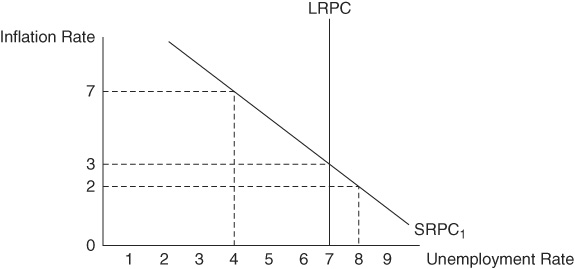
65. Figure 5 shows the macroeconomy in both the short run and the long run. In the long run, the unemployment rate will be _____ and the inflation rate will be _____.
A. 4 percent; 7 percent
B. 8 percent; 2 percent
C. 7 percent; 0 percent
D. 7 percent; 3 percent
66. Aggregate demand in the macroeconomy will shift to the right with:
A. An increase in household wealth
B. An increase in interest rates
C. A decrease in consumer optimism
D. A decrease in government spending
67. Which of the following statements are accurate?
I. The aggregate demand curve is downward-sloping because of the interest-rate effect.
II. The aggregate demand curve is downward-sloping because of the wealth effect.
III. The aggregate demand curve is downward-sloping because of the exchange-rate effect.
A. I only
B. I and II only
C. I, II, and III
D. II only
68. If the economy is in short-run equilibrium, what is the expected short-run impact of an increase in consumer optimism?
A. Aggregate demand increases, increasing the price level and increasing real output.
B. Aggregate demand increases, decreasing the price level and increasing real output.
C. Aggregate demand increases, increasing the price level and decreasing real output.
D. Short-run aggregate supply increases, decreasing the price level and increasing real output.
Use Figure 6 to answer questions 69 and 70.
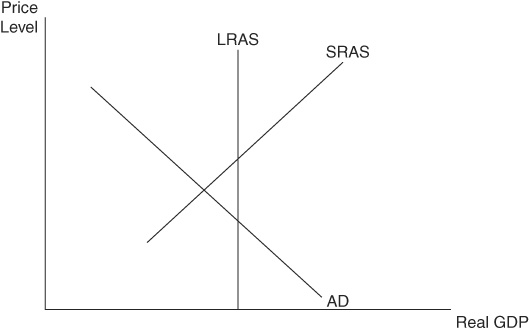
69. The economy depicted in the graph is currently in short-run equilibrium. What must be true of this economic situation?
A. The economy is currently at full employment.
B. The unemployment rate is higher than the natural rate of unemployment.
C. The economy is experiencing rapid inflation.
D. The economy is producing beyond the level that corresponds to full employment.
70. If the SRAS in the economy depicted in the graph is allowed to adjust to a long-run equilibrium, what would happen to factor prices, the SRAS curve, the unemployment rate, and the price level?

71. The paper currency that nations use today (like U.S. dollars and Mexican pesos) is referred to as ______ money. It can be used to purchase goods and services because the government declares that it is legal tender.
A. commodity
B. gold standard
C. barter
D. fiat
72. Suppose that Patrick takes $100 from his piggy bank and puts it into his checking account. How will this affect the M1 and M2 measures of money supply?
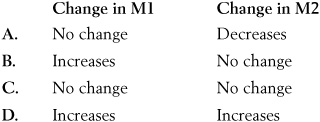
73. After Aunt Thelma passes away, the members of her family find $1,000 that has been hidden in the toaster for many years. They deposit the $1,000 into a new checking account. If banks have a reserve requirement of 0.05, the money multiplier is equal to:
A. 20
B. 5
C. 1,000
D. 10
74. After Aunt Thelma passes away, the members of her family find $1,000 that has been hidden in the toaster for many years. They deposit the $1,000 into a new checking account. If banks have a reserve requirement of 0.05, this deposit of $1,000 could eventually increase demand deposits by:
A. $20,000
B. $5,000
C. $10,000
D. $1,000
75. Suppose the demand for money increases. According to the liquidity preference theory, this will increase the _____ in the money market.
A. real GDP
B. Consumer Price Index
C. unemployment rate
D. interest rate
76. The _____ theory of macroeconomics believes that the _____ curve is vertical at full employment GDP.
A. classical; aggregate supply
B. classical; aggregate demand
C. Keynesian; short-run aggregate supply
D. Keynesian; long-run aggregate supply
77. If the economy is in a recession, the best fiscal policy would be to:
A. Increase taxes with no change in government spending.
B. Increase the money supply.
C. Increase government spending with no change in taxes.
D. Decrease the demand for loanable funds.
78. The marginal propensity to consume is 0.90. If government spending were to increase by $5 billion, this spending would multiply to a total of:
A. $500 billion
B. $40 billion
C. $15 billion
D. $50 billion
79. If the ecoppnomy is experiencing very low unemployment but a high inflation rate, the appropriate open market operation would be to:
A. Raise taxes
B. Lower government spending
C. Sell Treasury bonds
D. Raise the federal funds rate
80. Suppose the economy is currently in a recession as a result of weak aggregate demand. If policy makers take no action, we expect long-run economic output to ______ and the price level to _____.
A. return to full employment; decrease
B. continue to decrease; decrease
C. return to full employment; increase
D. increase beyond full employment; decrease
81. Suppose the produpction possibilities curve for a nation is linear. If all of the nation’s resources are used to produce cars, 1,000 cars can be produced. If all of the nation’s resources are used to produce candy, 5,000 candies can be produced. The opportunity cost of 1 car is equal to:
A. 1 candy
B. 5 candies
C. 5,000 candies
D. 20 candies
Use Table 6 to answer questions 82 and 83.
TABLE 6
82. Suppose that England and Ireland can both produce bread and butter. The production possibilities are given in Table 6. If England uses all its resources to produce bread, it can produce 30 units of bread. If it uses all its resources to produce butter, it can produce 30 units of butter. Likewise, if Ireland uses all its resources to produce bread, it can produce 10 units of bread. If it uses all its resources to produce butter, it can produce 20 units of butter. We know that:
A. Ireland has an absolute advantage in both bread and butter.
B. England has an absolute advantage in bread, and Ireland has an absolute advantage in butter.
C. Ireland has a comparative advantage in both bread and butter.
D. England has a comparative advantage in bread, and Ireland has a comparative advantage in butter.
83. Suppose that England and Ireland can both produce bread and butter. The production possibilities are given in Table 6. Given these production possibilities:
A. England will export butter to Ireland.
B. England will import bread from Ireland.
C. Ireland will import bread from England.
D. Ireland will export bread to England.
84. If goods produced in America become more popular in foreign countries, all else equal, we would expect:
A. Demand for the U.S. dollar to decrease, appreciating the dollar against other currencies
B. Demand for the U.S. dollar to increase, depreciating the dollar against other currencies
C. Demand for the U.S. dollar to increase, appreciating the dollar against other currencies
D. Supply of the U.S. dollar to increase, appreciating the dollar against other currencies
85. An American clothing company sells a T-shirt to a consumer in Canada. This transaction would show up as _____ in the U.S. _____ account.
A. an increase; current
B. a decrease; current
C. an increase; financial
D. a decrease; financial
86. Of the following choices, the best example of a public good is:
A. A cell phone
B. The local police department
C. A bottle of aspirin
D. A ticket to the opera
Use Figure 7 for questions 87 and 88.
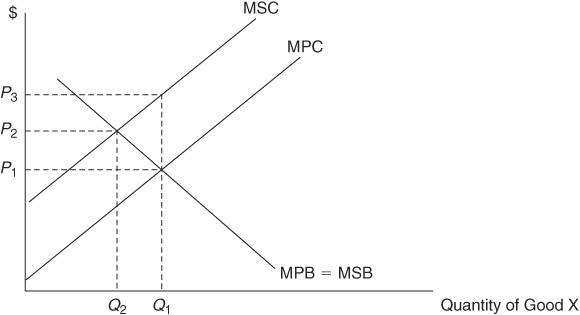
87. According to Figure 7, the market for good X exhibits a _____ externality because, at the market equilibrium quantity, the _____ is greater than the _____.
A. negative; MSB; MPB
B. negative; MSC; MSB
C. positive; MSC; MPC
D. negative; MPC; MPB
88. According to Figure 7, which of the following policies would remedy the externality in the market for good X?
A. Impose a per-unit tax equal to (P2 − P1).
B. Impose a per-unit subsidy equal to (P3 − P1).
C. Impose a per-unit tax equal to (P3 − P1).
D. Impose a per-unit tax equal to (P3 − P2).
89. Which of the following best describes a situation that generates a positive externality?
A. A trash incinerator is located in your neighborhood.
B. A farmer spreads chemical pesticides that leak into your drinking water.
C. A beekeeper lives down the street, and his honeybees fly to your yard and pollinate your cherry trees.
D. A neighbor has a swampy pond, and mosquitoes are often flying into your patio.
90. The socially efficient quantity of pollution is the quantity where:
A. The MSB = 0 for the last ton of pollution emitted.
B. The MSC = 0 for the last ton of pollution emitted.
C. Zero tons of pollution are emitted.
D. The MSB = MSC for the last ton of pollution emitted.
91. Mr. Pham receives health insurance from his employer that will pay nearly 100 percent of any illness or injury that he may suffer, after he pays a small deductible. Suppose Mr. Pham, now that he has health insurance, decides to train to climb Mount Everest. This kind of behavior is an example of:
A. Pooling behavior
B. Moral hazard
C. Symmetric information
D. The premium death spiral
92. When Betty was hospitalized for pneumonia, she was responsible for paying the first $1,000 of her bill, and her health insurance company paid the rest. This $1,000 payment represents Betty’s:
A. Deductible
B. Asymmetric information
C. Copayment
D. Actuarially fair premium
93. Suppose there is a health insurance pool of 1,000 people. Within the pool, 1 percent of the people will get very sick and suffer $200,000 in medical bills, while the other 99 percent of the people will remain healthy and have no medical bills. The health insurance firm must also charge each person in the pool a loading fee of $100. Including the loading fee, what is the premium that each person will be charged?
A. $2 million
B. $1,200
C. $2,100
D. $4,200
94. The problem of _____ affects the market for health insurance because the sickest people would be the most willing to pay for insurance.
A. insurance mandates
B. asymmetric information
C. adverse selection
D. copayments and deductibles
95. One way for a health insurance company to reduce the problem of moral hazard is to increase each policyholder’s:
A. Coverage
B. Copayment
C. Monthly premium
D. Loading fee
96. Samuel is a graduate student in economics and is beginning the research for his thesis. He is reading and summarizing what previous economists have discovered about his topic. At this stage in the research process, Samuel is said to be conducting:
A. A testable hypothesis
B. A data-gathering experiment
C. An empirical analysis
D. A literature review
97. Economic research is said to follow the scientific method because:
A. A hypothesis is statistically tested with available data and either confirmed or refuted.
B. A theory is confirmed with anecdotal evidence.
C. Past economic behavior is believed to predict future economic behavior.
D. Economic forecasts are made from the results of an empirical model.
98. Terrence owns a chain of convenience stores. He notices that when the weather is hot, he sells more cold fountain drinks. Terrence believes that there is a direct relationship between the high temperature on a given day and the quantity of cold fountain drinks that he sells on that day. This is an example of:
A. Empirical analysis
B. An economic theory
C. A literature review
D. A testable hypothesis
99. Raquel is working on her term paper in her economics class. She has gathered years of data and has begun to statistically measure the impact that a higher minimum wage has on teenage employment. In which stage of the research process is Raquel?
A. The literature review stage
B. The forecasting stage
C. The peer review stage
D. The empirical analysis stage
100. Most current economic research involves collecting data to statistically test hypotheses on how some economic variables affect other variables. This type of research is broadly known as:
A. Empirical economics
B. Literature reviews
C. Theoretical economics
D. The peer review process